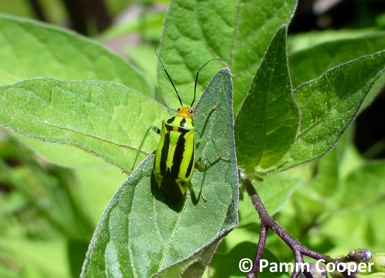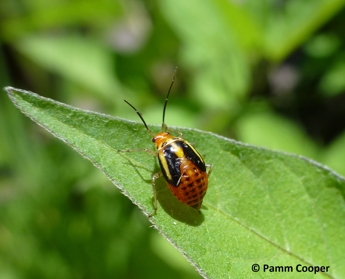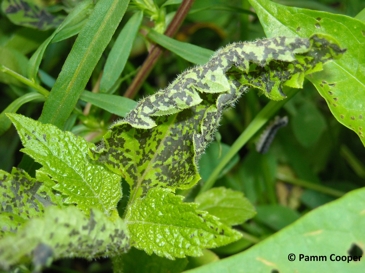Four-lined plant bug (Poecalocapsus linectus) is a piecing/sucking true bug that can cause unsightly damage to perennials, herbs, woody shrubs and some leafy vegetable plants, but damage is generally cosmetic and no control measures may be necessary. These insects are very small and are usually only discovered because of their tell-tale feeding damage.

Four-Lined Plant Bug Adult. Photo by Pamm Cooper, UConn Home & Garden Education Center

Four-Lined Plant Bug Nymph. Photo by Pamm Cooper, UConn Home & Garden Education Center
Feeding by the four-lined plant bug causes black, brown or translucent spots on leaves and damage may be mistaken for that of a disease.. if damage is severe, leaves may curl and turn brown,and may fall off the plant.. Spots where feeding has occurred are small, somewhat circular and uniform with smooth edges. Contributing to the illusion of disease is the fact that these insects are fast moving, frequently dropping to the ground, and hiding under foliage or flying away when disturbed, so they may not be seen on.the plants. A third reason people might think this is a disease is that dead plant tissue may drop out, leaving a shot hole. Many leaf spot diseases also have this symptom.

New damage appears as brown, sunken in spots. Photo by Pamm Cooper, UConn Home & Garden Education Center

As damage ages, it turns black on the leaf. Photo by Pamm Cooper, UConn Home & Garden Education Center
Description
As the common name suggests, adults of this true bug have four black longitudinal stripes surrounded by yellow to yellow-green on the leathery part of the wing covers. Beyond this, the membranous part of the wings is black. The head and body are a golden yellow with yellow-green legs that have black markings. Antennae are black. Adults are one-quarter inch in length. Nymphs are smaller, wingless, brightly-colored yellow to red, with black spots in rows on the segments of the abdomen. Mouthparts of adults and nymphs are piercing-sucking.
Life Cycle
This insect over-winters as eggs laid in linear slits near branch tips of woody plants. Eggs hatch in late spring after most foliage has emerged. The nymphs feed on the upper sides of leaves, withdrawing chlorophyll with their piercing-sucking mouthparts. Approximately 30 days and five molts later, the adults appear. Adults feed for about a month, then mate and the female lays eggs. There is only one generation each year.
Hosts
The four-lined plant bug feeds on many annuals, perennials, trees and shrubs, and vegetables. Azalea, dogwood, forsythia, honeysuckle, hydrangea, viburnum and weigela are some of the more common shrubs attacked. Shasta daisy, coreopsis, dahlia, morning glory, lavender, lupine, geranium and zinnia are some annuals and perennials that are attacked. Vegetables, small fruits and some herbs, such as basil and mints, also serve as hosts.
Management Methods
On ornamentals and leafy vegetables, where tolerance for injury is low, monitoring should begin by mid-May. At the first sign of injury, control measures should be taken. These insects are heavy feeders, and a few can cause much discoloration, so it's best to treat early.
Least toxic methods of control for ornamentals and edibles would include insecticidal soap and summer weight horticultural oils. Egg-laying slit sites are easily visible on trees and shrubs after leaf drop in the fall. Prune off twigs where the slits are seen.Hand-picking insects may be effective on single plants showing damage, or tap foliage of affected plants over a pail or soapy water to dislodge nymphs and adults. Leave them in the soapy water until they are dead.
References
Johnson, W. T. and H.H. Lyon.1994.Insects that Feed on Trees and Shrubs.Cornell University.p.396-397
Davidson, R.H. and L.M. Peairs.1966.Insect Pests of Farm, Garden and Orchard.John Wiley & Sons, Inc. p. 531
Pirone, P.O. 1978.Diseases and Pests of Ornamental Plants.John Wiley & Sons, Inc. pp.61, 199, 203, 210, 228,
247, 265, 310, 315, 339, 353, 354, 397, 538
University of Massachusetts Extension System.1994.1994 New England Management Recommendations for Insects,
Disease and Weeds of Shade Trees and Woody Ornamentals. Edited by Robert D. Childs. p. 117
Despite good cultural practices, pests and diseases at times may appear. Chemical control should be used only after all other methods have failed. For pesticide information please call UConn Home and Garden Education Center or your local cooperative extension office.
The UConn Home & Garden Education Center supports UConn Extension’s mission by providing answers you can trust with research-based information and resources. For gardening questions, contact us toll-free at (877) 486-6271, visit our website at homegarden.cahnr.uconn.edu, or reach out to your local UConn Extension center at cahnr.uconn.edu/extension/locations.
Revised by the UConn Home and Garden Education Center, 2016.